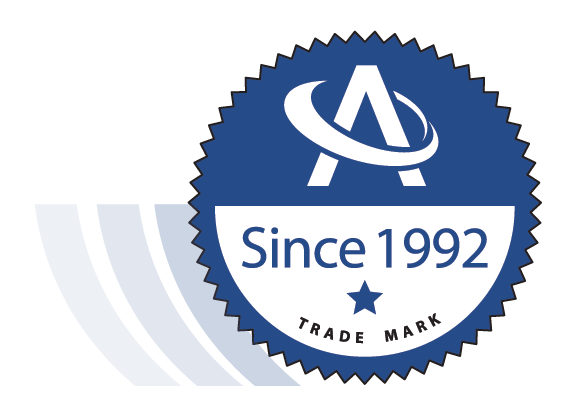Top 5 Durable Casters for Industrial Applications
Mar 13th 2025
Reliable mobility is essential for efficiency, safety, and productivity in industrial environments. Industrial casters are critical in transporting heavy loads, ensuring smooth movement, and reducing manual effort. However, choosing low quality or unsuitable casters can lead to occasional breakdowns, increased maintenance costs, and potential safety hazards. Investing in durable casters designed for high performance minimizes downtime and extends equipment lifespan, making them a vital component in warehouses, manufacturing plants, and distribution centers.
Casters are specialized wheel assemblies mounted to equipment, allowing easy movement across various surfaces. Multiple castor wheel types, including swivel, rigid, and locking casters, are available, each suited for specific applications. Understanding the types of casters available helps facility managers select the right option based on load capacity, floor conditions, and maneuverability needs. For extreme environments, such as construction sites or outdoor applications, off road casters provide superior durability and stability on uneven terrain.
Selecting the right casters for industrial use streamline operation and prevents unnecessary wear and tear. When choosing casters, facility managers must consider factors like weight capacity, material composition, and resistance to environmental conditions. Using the wrong casters can result in excessive wear, equipment damage, and costly replacements.
This article highlights the top 5 durable casters designed to withstand demanding industrial applications. Whether you need heavy duty casters for warehouse equipment or off road casters for rugged outdoor environments, this guide will help you find the best options to improve efficiency and reliability.
2. Understanding Industrial Casters
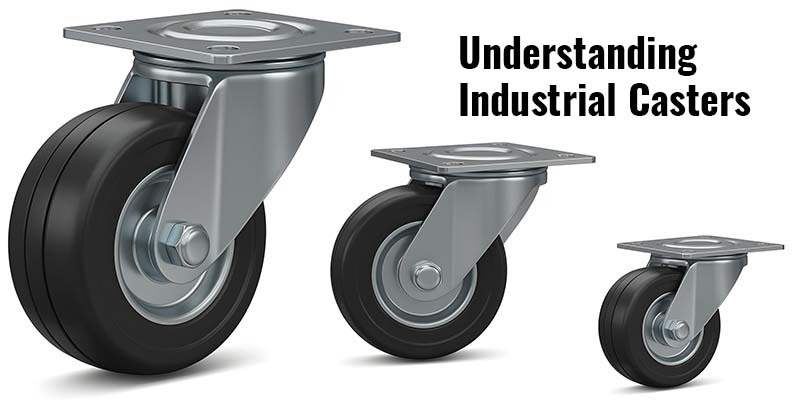
Selecting the right caster ensures smooth equipment movement, minimizes downtime, and improves workplace efficiency. Industrial casters come in various designs, each suited for specific applications. The following sections examine industrial casters, their classifications, and key factors while selecting the best caster for your needs.
What Are Industrial Casters?
Industrial casters are robust wheel assemblies designed to support and transport heavy loads in demanding environments. They are essential in manufacturing, warehousing, healthcare, and transportation, where equipment mobility is crucial. Unlike standard casters, heavy duty industrial casters are built to handle higher weight capacities while maintaining durability and stability.
These casters are available in various designs, including swivel, rigid, and kingpinless configurations, each offering unique benefits. Heavy equipment casters are commonly used in material handling, allowing for efficient movement of machinery, carts, and storage racks. The choice of caster type, wheel material, and load capacity directly impacts performance, safety, and longevity.
Types of Casters and Their Applications
Understanding different castor wheel types helps select the most suitable caster for an application. Each type is designed for specific movement and weight handling needs.
Swivel Casters
Swivel casters provide 360 degree rotation, making them ideal for highly maneuverable applications. These casters allow smooth direction changes, making them perfect for carts, medical equipment, and workstations in tight spaces.
Rigid Casters
Rigid casters offer straight line movement, providing stability for heavy duty industrial casters. They are commonly used on machinery, dollies, and transport carts that do not require frequent turning.
Kingpinless Casters
Kingpinless casters are designed for durability in high impact settings. They eliminate the traditional kingpin mechanism, a common failure point in standard casters. These casters are ideal for environments with high shock loads, such as manufacturing plants and heavy machinery transport.
Off Road Casters and All Terrain Casters
Off road and all terrain casters provide excellent durability and performance on rough or uneven surfaces for outdoor applications. They are commonly used in construction, agriculture, and outdoor material handling, where traditional casters may fail.
High Capacity Casters and Heavy Equipment Casters
Designed to support substantial loads, high capacity casters and heavy equipment casters ensure even weight distribution, preventing damage to flooring and equipment. These casters are essential in warehouses, aerospace, and heavy manufacturing industries.
Common Caster Wheel Types
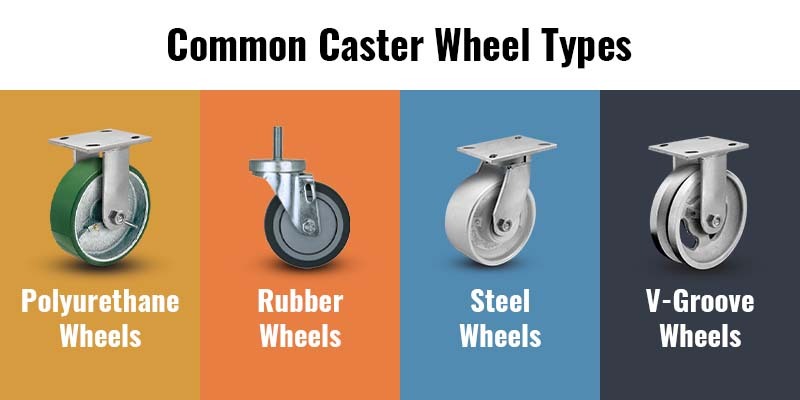
Selecting the right wheel material is crucial for caster performance. Here are some common castor wheel types and their applications:
- Polyurethane Wheels: Known for their durability, polyurethane caster wheels provide floor protection, noise reduction, and high load capacity. They are commonly used in warehouses, hospitals, and logistics operations.
- Rubber Wheels: Offering a cushioned ride, rubber wheels reduce noise and absorb shocks. They are suitable for delicate equipment, hospital carts, and office furniture.
- Steel Wheels: Extremely durable and capable of handling heavy loads, steel wheels are ideal for harsh industrial environments where strength and longevity are essential.
- V Groove Wheels: Designed to guide along tracks, V groove wheels provide controlled movement in assembly lines, automated systems, and material transport applications.
How to Choose the Right Caster Type
Selecting the right caster depends on several factors, including load capacity, maneuverability, surface conditions, and environmental exposure. Proper weight distribution ensures even load handling, reducing strain on individual casters and preventing premature failure. Heavy duty industrial casters with reinforced materials and high load ratings are recommended for industrial applications.
The floor type also plays a critical role in selection—polyurethane casters protect sensitive floors, while all terrain casters work best for rough surfaces. Businesses should consider environmental factors such as exposure to chemicals, moisture, and extreme temperatures to choose long lasting performance and reliability casters.
3. Key Factors and Considerations to Find Durable Casters
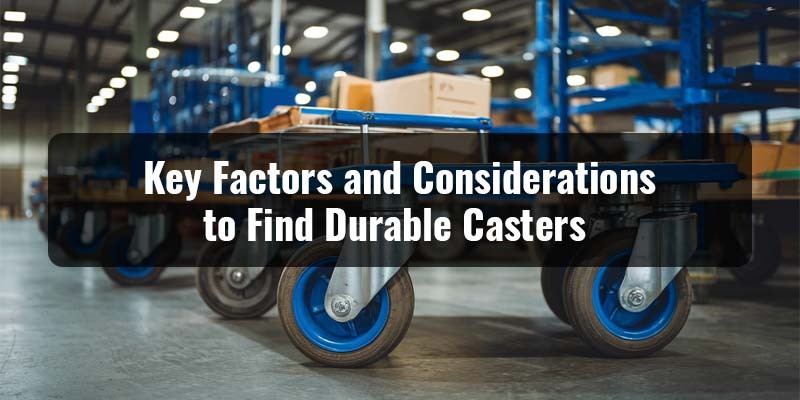
Selecting the right casters for industrial applications involves more than choosing a wheel that fits. Factors such as caster load capacity, material durability, environmental conditions, and maneuverability all play a role in determining a caster’s lifespan and performance. The following sections discuss the essential factors businesses should consider when choosing durable casters for industrial use.
Caster Load Capacity
Understanding caster load capacity is crucial to preventing premature failure and maintaining safe operations. Load capacity is calculated by dividing the total equipment weight (including its load) by the number of casters supporting it. However, to ensure even weight distribution, it’s best to select high capacity casters that can handle more than the minimum required weight.
For example, if a cart weighs 2,000 lbs. and uses four casters, each caster should have a load capacity of at least 500 lbs. However, to account for uneven floors, sudden impacts, and safety margins, choosing casters rated for 600 700 lbs. each provides extra durability and longevity. Overloading casters can lead to deformations, bearing failures, and increased rolling resistance, making equipment harder to maneuver. High capacity casters are designed with reinforced frames and heavy duty materials, ensuring long term performance in demanding industrial environments.
Material and Durability
The material of a caster directly affects its durability, load bearing capacity, and resistance to environmental wear. Common materials include polyurethane, rubber, steel, and iron, each offering distinct advantages.
- Polyurethane Casters: Polyurethane casters are highly durable, resistant to abrasion, and provide excellent floor protection. They also reduce noise and rolling resistance, making them ideal for warehouses, healthcare facilities, and manufacturing plants.
- Rubber Casters: Rubber wheels offer a cushioned ride and noise reduction but wear down faster under heavy loads. They work well in environments where vibration control is needed.
- Steel Casters: Steel wheels are robust and suited for high temperature and heavy duty applications. However, they can damage floors and generate noise.
- Iron Casters: These are durable and often used in extreme industrial conditions, such as foundries or heavy machinery transport.
Environmental Considerations
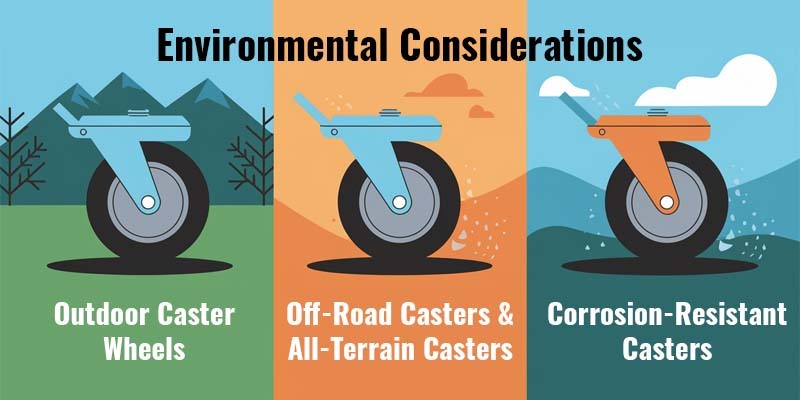
Casters must be suited to the environmental conditions in which they operate. In extreme temperatures, wet conditions, or corrosive environments, specialized casters are necessary to prevent material degradation and maintain performance.
- Outdoor Caster Wheels: Designed for exposure to moisture, dirt, and uneven ground, these casters resist corrosion and maintain stability.
- Off Road Casters and All Terrain Casters: These casters feature large, rugged wheels for superior traction on gravel, grass, and rough surfaces. They are commonly used in construction, agriculture, and outdoor material transport.
- Corrosion Resistant Casters: Stainless steel or zinc coated casters withstand harsh chemicals and moisture, making them ideal for food processing plants and marine applications.
Choosing off road or all terrain casters for outdoor and industrial applications prevents caster failure due to environmental wear, ensuring smooth movement and long term reliability.
Maneuverability and Stability
The type of caster affects how equipment moves, impacting efficiency, safety, and ease of use. Understanding the differences between swivel and rigid casters helps businesses get the best option for their operational needs.
- Swivel Casters: These casters rotate 360 degrees, providing excellent maneuverability in tight spaces. They are ideal for carts, workstations, and equipment requiring frequent directional changes.
- Rigid Casters: These casters move straight, offering more excellent stability for heavy loads. They are best for machinery, conveyor systems, and transport carts that need fixed movement paths.
Combining swivel casters and rigid casters can balance maneuverability and stability. For example, a four caster cart with two swivels in the front and two rigid casters in the back allows for controlled steering and easy turns. Ensuring proper weight distribution between these casters uplifts ergonomic efficiency and reduces strain on workers.
Safety and Compliance
Choosing the right casters is not just about performance—it’s also about workplace safety. Faulty or inadequate casters can cause accidents, equipment damage, and operational delays. Ensuring safety standard compliance essential for maintaining a secure work environment.
- Load Ratings: Selecting casters with load capacities higher than the minimum requirement prevents failures due to overloading.
- Brake and Locking Mechanisms: Secure locking casters prevent accidental rolling, reducing safety risks in loading docks and workstations.
- Industry Standards: Casters should meet safety certifications such as ANSI, OSHA, and ISO guidelines, ensuring reliability in industrial settings.
4. Top 5 Durable Casters for Industrial Applications
Selecting the best casters for industrial use requires considering factors like durability, weight distribution, and resistance to harsh conditions. Industrial environments demand heavy equipment casters to handle substantial loads without compromising mobility or safety. The right casters for heavy loads prevent breakdowns, reduce maintenance costs, and improve operational efficiency. Atlanta Caster offers top tier industrial casters for strength, longevity, and performance. Below, we review five of the most durable casters available, highlighting their unique features, benefits, and applications.
Polyurethane on Iron Casters
Polyurethane on iron casters combine a rigid iron core with a high performance polyurethane tread, making them one of the best casters for industrial use. The iron core provides exceptional strength, ensuring proper weight distribution for heavy equipment casters, while the polyurethane exterior uplifts floor protection and reduces noise. These casters resist chemicals, abrasion, and impact, ensuring long term reliability in demanding environments.
Best For
- Industrial machinery
- Warehouse carts
- Heavy duty material handling equipment
Features and Benefits
- High Load Capacity: The iron core structure supports casters for heavy loads, ensuring even weight distribution across all wheels.
- Floor Protection: Unlike hard metal wheels, polyurethane prevents scuffing and damage to concrete, tile, and epoxy coated floors.
- Noise Reduction: The polyurethane tread absorbs vibrations, reducing workplace noise levels.
- Chemical Resistance: Withstands exposure to oils, solvents, and industrial cleaning agents.
- Impact Absorption: Handles sudden impacts and heavy loads without cracking or deforming.
Applications
Polyurethane on iron casters is widely used in manufacturing plants, distribution centers, and automotive workshops. They provide reliable mobility for conveyor systems, production equipment, and transport carts. These casters excel in environments where high load bearing capacity and smooth rolling movement are essential for daily operations.
Rigid Steel Casters
Rigid steel casters are built for strength and stability, making them ideal for straight line movement applications. These casters feature solid steel wheels and reinforced frames, providing exceptional support for heavy equipment casters. With their ability to handle extreme weight, they are one of the best casters for heavy duty industrial applications.
Best For
- Machinery and equipment requiring fixed direction movement
- Industrial storage units
- Heavy duty assembly lines
Features and Benefits
- Maximum Weight Capacity: Designed as casters for heavy loads, rigid steel casters can support thousands of pounds without deforming.
- Straight Line Stability: Ideal for applications where precise movement control is required.
- Low Maintenance: The solid steel construction resists wear, reducing the need for frequent replacements.
- Temperature and Impact Resistance: Performs well in high heat environments and under sudden impacts.
- Smooth Rolling Performance: The steel wheel design ensures low rolling resistance, making it easier to move heavy equipment.
Applications
Rigid steel casters are commonly found in industrial storage units, manufacturing facilities, and assembly lines. Their ability to withstand extreme loads makes them indispensable for transporting large machinery and supporting production systems. These casters are particularly useful in settings where straight line movement is preferred over swivel based mobility.
Atlanta Caster’s polyurethane on iron and rigid steel casters are engineered for durability, reliability, and maximum performance. The following section will use additional heavy duty casters designed for the most demanding industrial conditions.
V Groove Casters
V Groove casters are designed for guided movement along tracks, providing precise directional control while reducing wear and tear. These heavy equipment casters ensure smooth and consistent rolling, preventing side to side drift and minimizing friction. Their durable construction allows them to handle casters for heavy loads, making them a top choice for industrial applications that require controlled movement. The V shaped groove, typically made of hardened steel or cast iron, provides excellent load bearing capacity while maintaining stability on rails or tracks.
Best For
- Assembly lines requiring precise movement
- Guided material transport systems
- Heavy duty racks used in industrial automation
Features and Benefits
- Secure Tracking: The V shaped wheel ensures stable movement along steel rails, improving control and reducing lateral movement.
- High Load Capacity: Designed as casters for heavy loads, V Groove casters support extreme weights with minimal rolling resistance.
- Durable Construction: Made with industrial grade materials such as steel or cast iron, these casters withstand constant wear, making them ideal for high impact applications.
- Smooth Operation: The precision machined groove allows seamless rolling on tracks, reducing friction and extending the caster's lifespan.
Applications
V Groove casters are widely used in manufacturing plants, conveyor systems, and industrial automation. They are ideal for guided transport lines where maintaining a fixed path is essential. These heavy equipment casters provide an efficient solution for material movement in production facilities, reducing operational inefficiencies and uplifting workflow precision.
Rubber on Steel Casters
The rubber on steel casters combines a resilient rubber exterior with a strong steel core, offering durability, noise reduction, and shock absorption. These casters are built to handle casters for heavy loads while providing a cushioned ride, reducing vibrations that can damage sensitive equipment. The rubber tread ensures even weight distribution, preventing excessive strain on floors while maintaining stability under heavy loads.
Best For
- Noise sensitive environments such as hospitals and laboratories
- Transporting delicate equipment that requires vibration control
- Environments where floor protection is a priority
Features and Benefits
- Quiet Operation: The rubber exterior absorbs sound, making it one of the best casters for noise sensitive applications.
- Shock Absorption: These casters reduce vibrations, protecting fragile equipment during transportation.
- Non Marking Surface: Unlike hard metal wheels, the rubber tread prevents scuffing or damaging floors.
- Better Weight Distribution: Ensures stability, preventing tipping and reducing wear on individual casters.
Applications
Rubber on steel casters are commonly found in healthcare facilities, laboratories, and retail stores. Their ability to handle heavy equipment casters while maintaining quiet and smooth operation makes them ideal for medical carts, rolling storage units, and sensitive transport equipment. These casters are especially useful in environments with critical floor preservation and reduced noise levels.
Kingpinless Swivel Casters
Kingpinless swivel casters eliminate the traditional kingpin mechanism, reducing stress points and increasing longevity. Unlike standard swivel casters, which are prone to failure at the kingpin joint, kingpinless casters distribute force evenly across the entire caster body. This improved weight distribution makes them highly durable and impact resistant, making them one of the best casters for high load, high impact applications.
Best For
- High impact environments with frequent shock loads
- Heavy machinery requiring smooth maneuverability
- Material handling carts found at warehouses and distribution centers
Features and Benefits
- Smooth Swiveling: Allows for effortless movement and easy directional changes, improving mobility for heavy equipment casters.
- High Impact Resistance: The absence of a kingpin prevents stress fractures, making them ideal for demanding industrial settings.
- Maintenance Free Design: With fewer moving parts, kingpinless casters require minor upkeep and have a longer lifespan than traditional swivel casters.
- Superior Weight Distribution: Handles casters for heavy loads without warping or losing structural integrity.
Applications
Kingpinless swivel casters are widely used in loading docks, heavy machinery transport, and material handling carts. Their robust construction enable handling of heavy loads in industrial and warehouse environments where durability and maneuverability are essential. These casters provide a long lasting, high performance solution for operations that demand frequent movement under heavy stress.
5. Benefits of Choosing the Right Casters
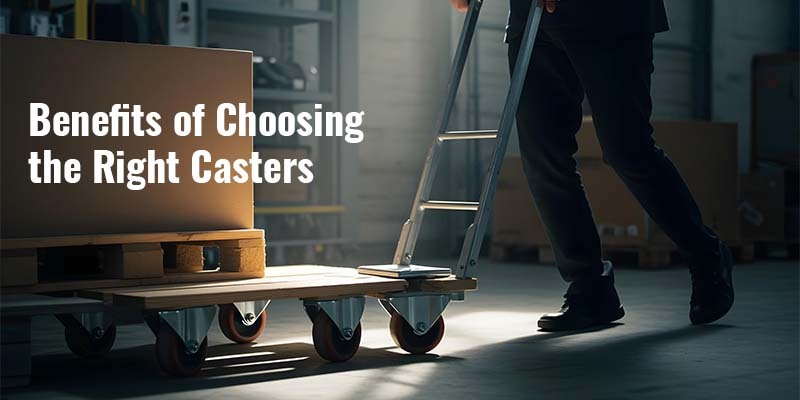
Selecting the right casters significantly improves workflow efficiency by reducing manual effort and streamlining movement. Equipment and carts must move smoothly across various surfaces in industrial settings to maintain productivity. High quality casters for heavy loads ensure minimal resistance, allowing workers to transport materials easily. This reduces time spent on repositioning equipment and prevents unnecessary strain on employees. Additionally, choosing casters with the correct weight distribution ensures even load handling, preventing misalignment and excessive wear. Businesses that invest in the best casters experience fewer disruptions, leading to increased operational efficiency and optimized material handling processes.
Safety and Stability
Durable casters are critical in workplace safety, preventing tipping hazards and equipment damage. Heavy equipment casters with reinforced frames and high load capacities provide better stability, ensuring that machinery and transport carts remain secure during movement. Casters designed for specific environments—such as all terrain casters for rough surfaces or polyurethane casters for smooth flooring—help prevent accidents caused by wheel failure or poor traction. Additionally, selecting casters with locking mechanisms and proper load ratings reduces the risk of workplace injuries. Safety compliant casters improve overall stability, protecting both personnel and valuable equipment.
Cost Efficiency and Maintenance Savings
Investing in high capacity casters reduces long term operational costs by minimizing maintenance and replacement expenses. Low quality casters wear out quickly, leading to frequent breakdowns and downtime. High performance casters, such as casters polyurethane, offer superior durability, reducing the need for constant repairs. Additionally, casters with corrosion resistant materials and sealed bearings require less maintenance, lowering operational costs. By choosing durable casters, businesses save money on repairs, replacements, and labor costs associated with malfunctioning mobility solutions.
Improved Worker Comfort and Ergonomics
The right casters improve worker comfort by reducing the physical strain required to move heavy loads. Casters with smooth rolling capabilities, shock absorption, and precision bearings reduce push/pull force, preventing workplace injuries such as muscle strain and fatigue. Best casters for ergonomic efficiency ensure that employees can maneuver carts and equipment effortlessly, increasing overall job satisfaction. Whether in warehouses, hospitals, or manufacturing facilities, ergonomically designed casters create a safer, more comfortable working environment.
6. Maintenance Tips for Industrial Casters
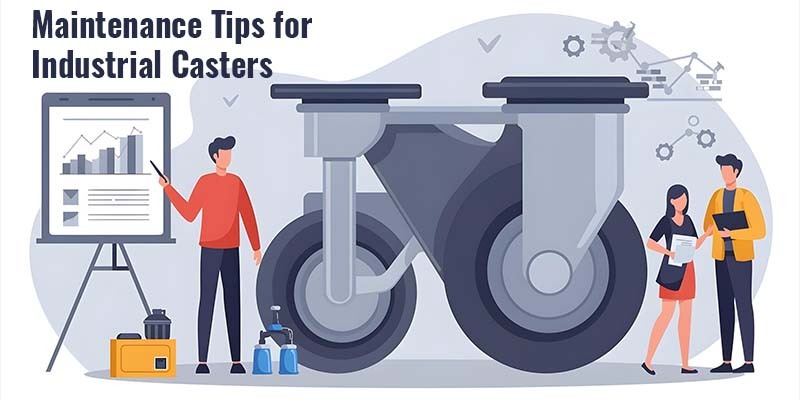
Establishing a routine wheel maintenance schedule is essential for preventing caster failure and ensuring long term performance. Regular inspections help identify worn out treads, misaligned wheels, or damaged bearings before they lead to costly replacements. Heavy equipment casters in high load applications should be checked for deformations or stress fractures that compromise stability. Cleaning casters regularly prevents debris buildup, which can obstruct smooth movement and increase rolling resistance. Dirt, grease, and industrial residues should be removed using appropriate cleaning agents to maintain optimal performance.
Proper Lubrication
Lubrication is essential for ensuring that casters operate smoothly without excessive friction. Bearings, swivel joints, and axles should be lubricated periodically to reduce wear and improve maneuverability. Casters for heavy loads experience high stress levels, making it crucial to use high quality lubricants designed for industrial applications. Proper lubrication prevents components from seizing up, extending the lifespan of casters and reducing the effort required for movement. Businesses should follow manufacturer recommendations for lubrication frequency and use grease resistant water and chemicals for casters operating in harsh environments.
Timely Replacements and Upgrades
Knowing when to replace or upgrade casters is crucial to maintaining efficiency and safety. Common signs that casters need a replacement include uneven wear, flat spots on wheels, difficulty swiveling, and excessive noise during movement. High capacity casters should be replaced immediately if structural damage is detected, as failing casters can lead to equipment damage or workplace accidents. Upgrading to more advanced caster models like kingpins or shock absorbing casters can improve performance in high impact environments. Keeping an inventory of spare casters ensures quick replacements, minimizing downtime.
Storage and Usage Best Practices
Proper storage and handling practices extend the lifespan of industrial casters. Casters should be stored in dry, clean environments to prevent rust and corrosion, particularly for outdoor caster wheels or those exposed to moisture. Equipment fitted with casters should be used on appropriate surfaces to avoid unnecessary wear—all terrain casters should be used on rough surfaces. In contrast, polyurethane casters are best suited for smooth warehouse floors. Avoiding overloading carts beyond the recommended weight capacity helps maintain proper weight distribution, ensuring casters perform efficiently over time.
7. Wrapping Up
Choosing the right heavy equipment casters is essential for maintaining operational efficiency, workplace safety, and long term cost savings. Casters for heavy loads must provide proper weight distribution, ensuring smooth movement, reduced strain on workers, and minimal wear on floors. Investing in durable casters designed for specific industrial applications—such as polyurethane on iron casters for warehouse carts or kingpin less swivel casters for high impact environments—prevents frequent breakdowns and unnecessary replacements. Proper maintenance, including regular inspections, lubrication, and timely upgrades, extends the caster lifespan and uplifts overall performance.
Now is the time to assess your current equipment and determine if your casters meet the demands of your industrial environment. Upgrading to high capacity casters can reduce downtime, improve workflow, and create a safer workplace. High quality casters provide long term value, minimizing repair costs and increasing productivity.
For the best casters built for strength, reliability, and efficiency, check out Atlanta Caster’s extensive selection of premium industrial casters. Visit our website today to find the perfect casters for heavy loads and ensure seamless mobility in your operations.




 Email US
Email US
 Hours
Hours
 Visit Our Showroom
Visit Our Showroom




